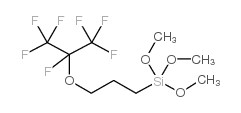3-(heptafluoroisopropoxy)propyltrimethoxysilane
Modify Date: 2024-04-03 18:25:19

3-(heptafluoroisopropoxy)propyltrimethoxysilane structure
|
Common Name | 3-(heptafluoroisopropoxy)propyltrimethoxysilane | ||
|---|---|---|---|---|
| CAS Number | 19116-61-1 | Molecular Weight | 348.28700 | |
| Density | 1.25 | Boiling Point | 85ºC (3 mmHg) | |
| Molecular Formula | C9H15F7O4Si | Melting Point | N/A | |
| MSDS | N/A | Flash Point | 79.1ºC | |
| Name | 3-(1,1,1,2,3,3,3-heptafluoropropan-2-yloxy)propyl-trimethoxysilane |
|---|
| Density | 1.25 |
|---|---|
| Boiling Point | 85ºC (3 mmHg) |
| Molecular Formula | C9H15F7O4Si |
| Molecular Weight | 348.28700 |
| Flash Point | 79.1ºC |
| Exact Mass | 348.06300 |
| PSA | 36.92000 |
| LogP | 3.06160 |
| Vapour Pressure | 3.16E-05mmHg at 25°C |
| Index of Refraction | 1.346-1.348 |
Synonym:None Section 2 - COMPOSITION, INFORMATION ON INGREDIENTS
Risk Phrases: 36/37/38 Section 3 - HAZARDS IDENTIFICATION EMERGENCY OVERVIEW
Irritating to eyes, respiratory system and skin. Potential Health Effects Eye: Causes eye irritation. May cause conjunctivitis. May cause blindness. Contact with the eyes may cause corneal damage. Skin: Causes skin irritation. May be harmful if absorbed through the skin. Ingestion: May cause irritation of the digestive tract. May cause systemic toxic effects on the heart, liver, and kidneys. May cause central nervous system effects. May cause headache, nausea, fatigue, and dizziness. May be harmful if swallowed. Inhalation: Causes respiratory tract irritation. May be harmful if inhaled. Chronic: Not available. Section 4 - FIRST AID MEASURES Eyes: Flush eyes with plenty of water for at least 15 minutes, occasionally lifting the upper and lower eyelids. Get medical aid. Skin: Get medical aid. Flush skin with plenty of water for at least 15 minutes while removing contaminated clothing and shoes. Ingestion: Get medical aid. Wash mouth out with water. Inhalation: Remove from exposure and move to fresh air immediately. If not breathing, give artificial respiration. If breathing is difficult, give oxygen. Get medical aid. Notes to Physician: Section 5 - FIRE FIGHTING MEASURES General Information: As in any fire, wear a self-contained breathing apparatus in pressure-demand, MSHA/NIOSH (approved or equivalent), and full protective gear. Contact with water liberates highly flammable gases. Extinguishing Media: Use carbon dioxide or dry chemical. Section 6 - ACCIDENTAL RELEASE MEASURES General Information: Use proper personal protective equipment as indicated in Section 8. Spills/Leaks: Absorb spill with inert material (e.g. vermiculite, sand or earth), then place in suitable container. Remove all sources of ignition. Provide ventilation. Do not expose spill to water. Section 7 - HANDLING and STORAGE Handling: Wash thoroughly after handling. Remove contaminated clothing and wash before reuse. Use with adequate ventilation. Avoid contact with eyes, skin, and clothing. Avoid breathing vapor or mist. Storage: Store in a cool, dry place. Store in a tightly closed container. Store protected from moisture. Section 8 - EXPOSURE CONTROLS, PERSONAL PROTECTION Engineering Controls: Facilities storing or utilizing this material should be equipped with an eyewash facility and a safety shower. Use adequate ventilation to keep airborne concentrations low. Exposure Limits CAS# 19116-61-1: Personal Protective Equipment Eyes: Wear chemical splash goggles. Skin: Wear appropriate protective gloves to prevent skin exposure. Clothing: Wear appropriate protective clothing to prevent skin exposure. Respirators: Follow the OSHA respirator regulations found in 29 CFR 1910.134 or European Standard EN 149. Use a NIOSH/MSHA or European Standard EN 149 approved respirator if exposure limits are exceeded or if irritation or other symptoms are experienced. Section 9 - PHYSICAL AND CHEMICAL PROPERTIES Physical State: Liquid Color: clear, colorless Odor: ethereal odor pH: Not available. Vapor Pressure: Not available. Viscosity: Not available. Boiling Point: 85 deg C @ 3 mmHg Freezing/Melting Point: Not available. Autoignition Temperature: Not available. Flash Point: Not available. Explosion Limits, lower: Not available. Explosion Limits, upper: Not available. Decomposition Temperature: Solubility in water: Reacts. Specific Gravity/Density: 1.25 Molecular Formula: C9H15F7O4Si Molecular Weight: 348.29 Section 10 - STABILITY AND REACTIVITY Chemical Stability: Stable. Material generates methanol on contact with water or moisture on the skin, eyes and mucous membranes. Conditions to Avoid: Excess heat, Reacts with water to form methanol. The heat of the reaction may ignite the vapor of the alcohol.. Incompatibilities with Other Materials: Strong oxidizing agents, strong acids, water. Hazardous Decomposition Products: Carbon monoxide, carbon dioxide, hydrogen fluoride gas, silicon dioxide, methanol. Hazardous Polymerization: Has not been reported Section 11 - TOXICOLOGICAL INFORMATION RTECS#: CAS# 19116-61-1 unlisted. LD50/LC50: Not available. Carcinogenicity: 3-Heptafluoroisopropoxypropyltrimethoxysilane - Not listed by ACGIH, IARC, or NTP. Section 12 - ECOLOGICAL INFORMATION Section 13 - DISPOSAL CONSIDERATIONS Dispose of in a manner consistent with federal, state, and local regulations. Section 14 - TRANSPORT INFORMATION IATA Not regulated as a hazardous material. IMO Not regulated as a hazardous material. RID/ADR Not regulated as a hazardous material. Section 15 - REGULATORY INFORMATION European/International Regulations European Labeling in Accordance with EC Directives Hazard Symbols: XI Risk Phrases: R 36/37/38 Irritating to eyes, respiratory system and skin. Safety Phrases: S 26 In case of contact with eyes, rinse immediately with plenty of water and seek medical advice. S 37/39 Wear suitable gloves and eye/face protection. WGK (Water Danger/Protection) CAS# 19116-61-1: No information available. Canada None of the chemicals in this product are listed on the DSL/NDSL list. CAS# 19116-61-1 is not listed on Canada's Ingredient Disclosure List. US FEDERAL TSCA CAS# 19116-61-1 is not listed on the TSCA inventory. It is for research and development use only. SECTION 16 - ADDITIONAL INFORMATION N/A |
| Hazard Codes | Xi: Irritant; |
|---|---|
| Risk Phrases | R36/37/38 |
| Safety Phrases | 37/39-26 |